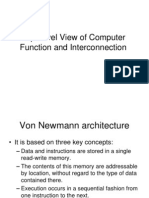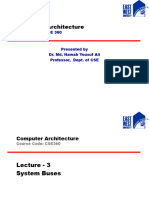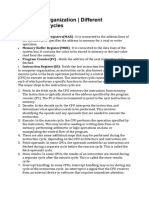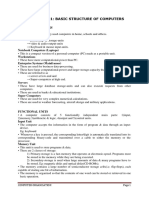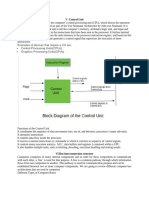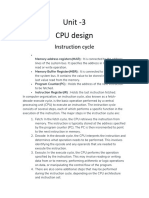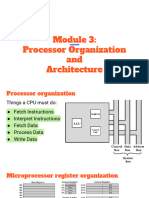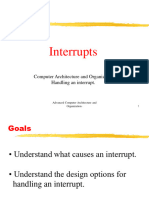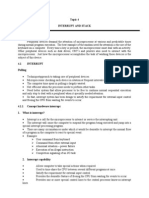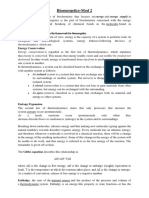0 ratings0% found this document useful (0 votes)
17 viewsModule#3 - Basic Processing Unit
Uploaded by
Gayathri potnuru JioCopyright
© © All Rights Reserved
Available Formats
Download as PDF, TXT or read online on Scribd
0 ratings0% found this document useful (0 votes)
17 viewsModule#3 - Basic Processing Unit
Uploaded by
Gayathri potnuru JioCopyright
© © All Rights Reserved
Available Formats
Download as PDF, TXT or read online on Scribd
You are on page 1/ 7
Basic Processing Unit
A program consisting of the memory unit of the computer includes a series of
instructions.
The program is implemented on the computer by going through a cycle for
each instruction.
In the basic computer, each instruction cycle includes the following steps:
It can fetch instruction from memory.
It is used to decode the instruction.
It can read the effective address from memory if the instruction has an indirect
address.
It can execute the instruction.
After the following four procedures are done, the control switches back to the
first step and repeats the similar process for the next instruction. Therefore, the
cycle continues until a Halt condition is met. The figure shows the phases
contained in the instruction cycle.
Basic Instruction Cycle
• Instruction Address Calculation − The address of the next instruction is computed. A permanent number is
inserted to the address of the earlier instruction.
• Instruction Fetch− The instruction is read from its specific memory location to the processor.
• Instruction Operation Decoding − The instruction is interpreted and the type of operation to be implemented
and the operand(s) to be used are decided.
• Operand Address Calculation− The address of the operand is evaluated if it has a reference to an operand in
memory or is applicable through the Input/Output.
• Operand Fetch − The operand is read from the memory or the I/O.
• Data Operation − The actual operation that the instruction contains is executed.
• Store Operands − It can store the result acquired in the memory or transfer it to the I/O.
Interrupt
An interrupt is a signal from a device attached to a computer or from a program within the computer
that requires the operating system to stop and figure out what to do next.
Whenever an interrupt occurs, it causes the CPU to stop executing the current program. Then comes
the control to interrupt the handler or interrupt service routine.
The steps in which ISR handle interrupts are as follows −
• Step 1 − When an interrupt occurs let assume processor is executing i'th instruction and program
counter will point to the next instruction (i+1)th.
• Step 2 − When an interrupt occurs the program value is stored on the process stack and the
program counter is loaded with the address of interrupt service routine.
• Step 3 − Once the interrupt service routine is completed the address on the process stack is popped
and placed back in the program counter.
• Step 4 − Now, it executes the resume for (i+1)th line.
Multiple interrupts
• Multiple interrupt is an interrupt event which can occur while the processor is handling a previous
interrupt.
• Ways to handle interrupts
• Disable interrupt
• Define priorities
Instruction Cycle with Interrupts
Distinction between Hardware Interrupt and Software Interrupt
You might also like
- Top Level View of Computer Function and InterconnectionNo ratings yetTop Level View of Computer Function and Interconnection38 pages
- Computer Function: 1. Reading (Fetching) Instruction From Memory by CPU 2. Execution of Each Fetched InstructionNo ratings yetComputer Function: 1. Reading (Fetching) Instruction From Memory by CPU 2. Execution of Each Fetched Instruction19 pages
- CSC 205 - 2 Instruction Processing 2023-2024No ratings yetCSC 205 - 2 Instruction Processing 2023-202435 pages
- Computer Instructions, Timing and Control, Instruction CycleNo ratings yetComputer Instructions, Timing and Control, Instruction Cycle4 pages
- STW120CT Computer Architecture and Networks: (Instruction Pipelining)No ratings yetSTW120CT Computer Architecture and Networks: (Instruction Pipelining)24 pages
- Lecture 2 Top Level View of Computer Function and InterconnectionNo ratings yetLecture 2 Top Level View of Computer Function and Interconnection29 pages
- Unit-3 - Execution of A Complete Instruction100% (1)Unit-3 - Execution of A Complete Instruction2 pages
- Instruction Cycle, Machine Cycle and T stateNo ratings yetInstruction Cycle, Machine Cycle and T state12 pages
- William Stallings Computer Organization and Architecture 8 EditionNo ratings yetWilliam Stallings Computer Organization and Architecture 8 Edition52 pages
- Program Instruction Memory Central Processing Unit Bootup100% (1)Program Instruction Memory Central Processing Unit Bootup4 pages
- William Stallings Computer Organization and Architecture 8 EditionNo ratings yetWilliam Stallings Computer Organization and Architecture 8 Edition59 pages
- 3.2 Computer Function: Reads (Fetches) InstructionsNo ratings yet3.2 Computer Function: Reads (Fetches) Instructions20 pages
- William Stallings Computer Organization and Architecture 7 Edition System BusesNo ratings yetWilliam Stallings Computer Organization and Architecture 7 Edition System Buses91 pages
- Operating Systems Interview Questions You'll Most Likely Be AskedFrom EverandOperating Systems Interview Questions You'll Most Likely Be AskedNo ratings yet
- Xii HSC - Board - March - 2018: Computer Science - Ii (D-9) QP + SolutionsNo ratings yetXii HSC - Board - March - 2018: Computer Science - Ii (D-9) QP + Solutions16 pages
- B.Tech Third Year Syllabus - EMBEDDED SYSTEMSNo ratings yetB.Tech Third Year Syllabus - EMBEDDED SYSTEMS6 pages
- Lesson 1 - Evolution of Microprocessor PDFNo ratings yetLesson 1 - Evolution of Microprocessor PDF59 pages
- THE VON NEUMANN MACHINE - Components of CPU, Buses, RegistersNo ratings yetTHE VON NEUMANN MACHINE - Components of CPU, Buses, Registers4 pages
- HPE - A00100074en - Us - ClearPass Policy Manager 6.9 Scaling and Ordering GuideNo ratings yetHPE - A00100074en - Us - ClearPass Policy Manager 6.9 Scaling and Ordering Guide17 pages
- An Operating System Acts As An Intermediary Between The User of ANo ratings yetAn Operating System Acts As An Intermediary Between The User of A3 pages
- COMPUTER LITERACY BASICS: A COMPREHENSIVE GUIDE TO IC3 5 TH EDITION BY: MORRISON, C., WELLS, D. AND RUFOLLO, Chapter 1No ratings yetCOMPUTER LITERACY BASICS: A COMPREHENSIVE GUIDE TO IC3 5 TH EDITION BY: MORRISON, C., WELLS, D. AND RUFOLLO, Chapter 143 pages
- RGPV Syllabus Cbgs Cs 6 Sem All Subjects PDFNo ratings yetRGPV Syllabus Cbgs Cs 6 Sem All Subjects PDF12 pages
- 8085 Microprocessor Programs: Microprocessor & Microcontroller Lab ManualNo ratings yet8085 Microprocessor Programs: Microprocessor & Microcontroller Lab Manual16 pages
- Go Negosyo: 21 Steps To Start and Grow Your Business100% (1)Go Negosyo: 21 Steps To Start and Grow Your Business73 pages
- Computer Architecture and Organization Chapter 5 &6No ratings yetComputer Architecture and Organization Chapter 5 &622 pages
- Top Level View of Computer Function and InterconnectionTop Level View of Computer Function and Interconnection
- Computer Function: 1. Reading (Fetching) Instruction From Memory by CPU 2. Execution of Each Fetched InstructionComputer Function: 1. Reading (Fetching) Instruction From Memory by CPU 2. Execution of Each Fetched Instruction
- Computer Instructions, Timing and Control, Instruction CycleComputer Instructions, Timing and Control, Instruction Cycle
- STW120CT Computer Architecture and Networks: (Instruction Pipelining)STW120CT Computer Architecture and Networks: (Instruction Pipelining)
- Lecture 2 Top Level View of Computer Function and InterconnectionLecture 2 Top Level View of Computer Function and Interconnection
- William Stallings Computer Organization and Architecture 8 EditionWilliam Stallings Computer Organization and Architecture 8 Edition
- Program Instruction Memory Central Processing Unit BootupProgram Instruction Memory Central Processing Unit Bootup
- William Stallings Computer Organization and Architecture 8 EditionWilliam Stallings Computer Organization and Architecture 8 Edition
- 3.2 Computer Function: Reads (Fetches) Instructions3.2 Computer Function: Reads (Fetches) Instructions
- William Stallings Computer Organization and Architecture 7 Edition System BusesWilliam Stallings Computer Organization and Architecture 7 Edition System Buses
- Operating Systems Interview Questions You'll Most Likely Be AskedFrom EverandOperating Systems Interview Questions You'll Most Likely Be Asked
- Xii HSC - Board - March - 2018: Computer Science - Ii (D-9) QP + SolutionsXii HSC - Board - March - 2018: Computer Science - Ii (D-9) QP + Solutions
- THE VON NEUMANN MACHINE - Components of CPU, Buses, RegistersTHE VON NEUMANN MACHINE - Components of CPU, Buses, Registers
- HPE - A00100074en - Us - ClearPass Policy Manager 6.9 Scaling and Ordering GuideHPE - A00100074en - Us - ClearPass Policy Manager 6.9 Scaling and Ordering Guide
- An Operating System Acts As An Intermediary Between The User of AAn Operating System Acts As An Intermediary Between The User of A
- COMPUTER LITERACY BASICS: A COMPREHENSIVE GUIDE TO IC3 5 TH EDITION BY: MORRISON, C., WELLS, D. AND RUFOLLO, Chapter 1COMPUTER LITERACY BASICS: A COMPREHENSIVE GUIDE TO IC3 5 TH EDITION BY: MORRISON, C., WELLS, D. AND RUFOLLO, Chapter 1
- 8085 Microprocessor Programs: Microprocessor & Microcontroller Lab Manual8085 Microprocessor Programs: Microprocessor & Microcontroller Lab Manual
- Go Negosyo: 21 Steps To Start and Grow Your BusinessGo Negosyo: 21 Steps To Start and Grow Your Business
- Computer Architecture and Organization Chapter 5 &6Computer Architecture and Organization Chapter 5 &6

